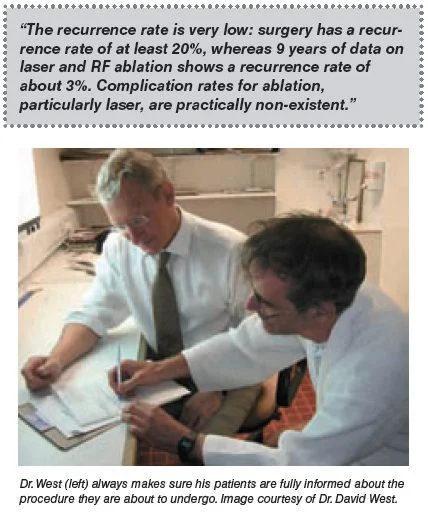HealthManagement, IQ_2012_06_venus
The Treatment
Laser ablation (also called endovenous laser treatment or ELT/EVLT) is very similar to radiofrequency (RF) ab lation: by applying heat from within, the malfunctioning vein can be sealed off. In a similar manner to RF ablation, a very thin laser fibre is inserted into the vein under local anaesthetic. Once in place, the laser is switched on and slowly withdrawn down the vein. The heat literally melts the vein shut, stopping blood flowing through it. Dr. David West, who runs a number of successful vein clinics throughout England, explains how laser ablation is performed, and what advantages it offers. “The key to a successful treatment is imaging. It’s essential to accurately map the anatomy and physiology of the veins you intend to treat – no matter what treatment you intend to use. The best method of doing this is colour duplex ultrasound scanning. A simple handheld Doppler examination is just not good enough. You may achieve short-term success, but the problem will recur and get worse. “Laser ablation itself must be carried out under ultrasound- guidance. If the laser went into a deep vein, it could result in a very nasty deep vein thrombosis (DVT). So it is essential that the performing physician has the required ultrasound skills.”
Safety First!
“The laser works by burning the vein, but there are a number of safety features central to the procedure to ensure that only the malfunctioning vein is affected. “Once the laser fibre is in place, we inject a saline solution alongside the vein, which has a triple safety effect: it causes the distended vein to spasm and hold tightly to the tube inside it, allowing direct contact for maximum heat effect. The saline also cools everything surrounding the vein, as well as pushing all the surrounding nerves and arteries safely out of the way. “The laser fibre itself is fitted with a red light, which is vi - sible through the skin, even on very large patients. This shows you where the laser is, allowing you to ensure that it’s correctly placed. If you don’t see the light, you don’t turn on the laser. Safety is very important to us.”
Ablation Methods Compared
“Both RF and laser have their own advantages. Laser seems to cause more discomfort and bruising than RF, but the trade-off is that it has a much lower rate of serious complications. Newer laser machines with longer wavelength frequencies are meant to reduce the minor postprocedural discomfort that is associated with laser, so it will be interesting to see the data on that in a few years. “Additionally, about 10% of patients will not be suitable for RF ablation, whereas laser can be used in almost all patients. Both therapies are equally effective.”
The Beauty of Ablation
“Both ablation procedures offer significant advantages to surgery. Ablation can be performed on an outpatient basis, and entails a much shorter recovery time. With most patients, all refluxing veins can be treated in one session. Each leg takes about 15-30 minutes. The way I run my clinic, consultation, scan, discussion and treatment take 90 minutes in total. After compression stockings and 15 minutes of walking about, patients are free to go home. Six weeks later, I perform follow-up, and if necessary, treat any residual varicosities.”



